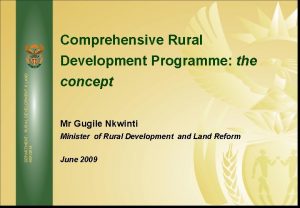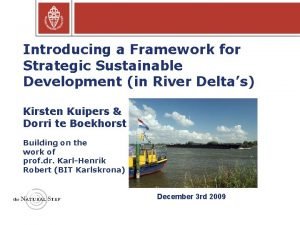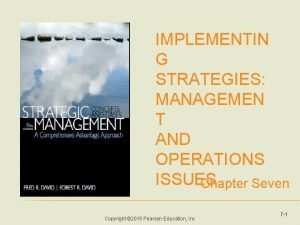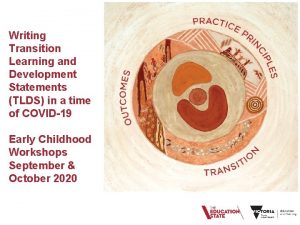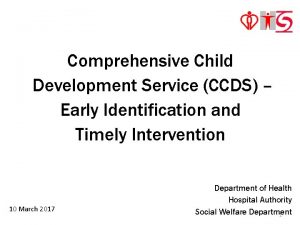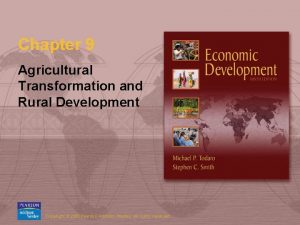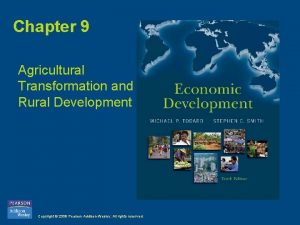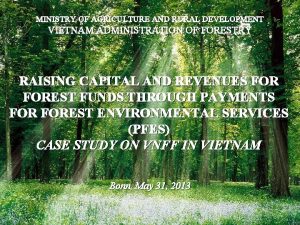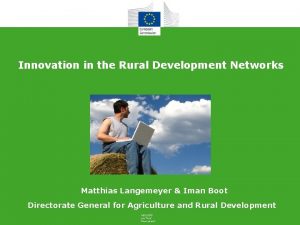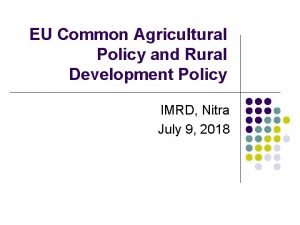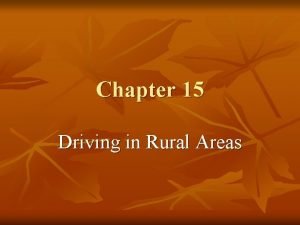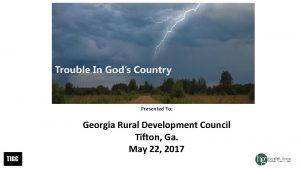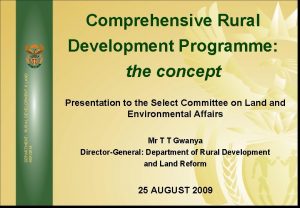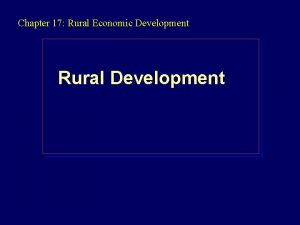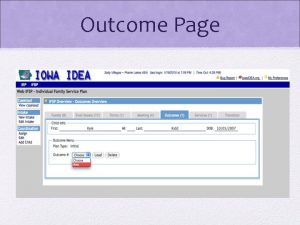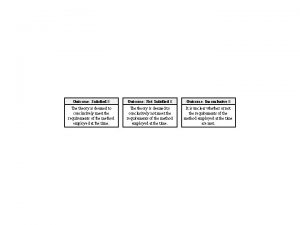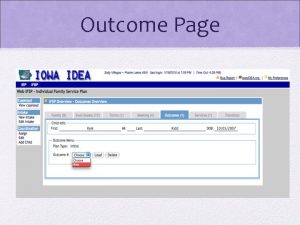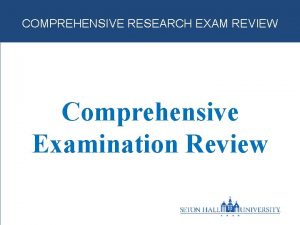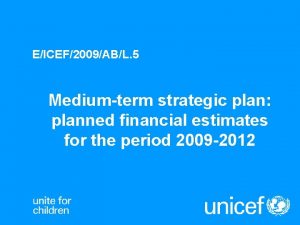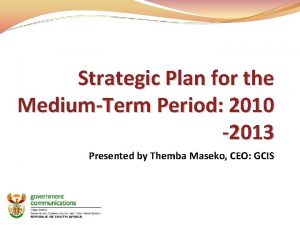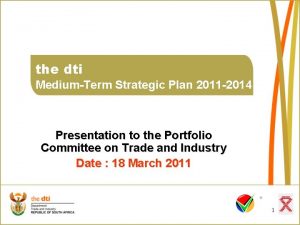OUTCOME 7 COMPREHENSIVE RURAL DEVELOPMENT MEDIUMTERM STRATEGIC FRAMEWORK

















- Slides: 17

OUTCOME 7 COMPREHENSIVE RURAL DEVELOPMENT: MEDIUM-TERM STRATEGIC FRAMEWORK, 2014 -19 A presentation to the Portfolio Committee on Rural Development, 02 February 2016 Dr. Ngomane T.

THE MEDIUM-TERM STRATEGIC FRAMEWORK (MTSF) Ø The MTSF is government’s first five year implementation plan of the NDP, covering the financial years 2014/15 to 2018/2019 Ø There are 14 outcomes (aligned to the NDP) over the financial period 2015/16. 1. Quality basic education 2. A long and healthy life for all 3. All people in South Africa are and feel safe 4. Decent employment through inclusive economic growth 5. Skilled and capable workforce to support an inclusive growth path 6. An efficient, competitive and responsive economic infrastructure network 7. Vibrant, equitable, sustainable rural communities contributing to food security for all 8. 9. 10. 11. 12. 13. 14. Sustainable human settlements and improved quality of household life Responsive, accountable, effective and efficient local government system Protect and enhance our environmental assets and natural resources Create a better South Africa, a better Africa and a better world An efficient, effective and development oriented public service Social protection Nation building and social cohesion 2

An integrated and inclusive rural economy (1) Chapter 6 of the NDP, “an integrated and inclusive rural economy”, provides for the differentiated rural development strategy that focuses on: 1. Agricultural development based on successful land reform, employment creation and strong environmental safeguards. To achieve this, irrigated agriculture and dry-land production should be expanded, with emphasis on small-holder farmers where possible Currently 1. 6 M Ha of land is under irrigation. A detailed survey conducted by DWS, indicates that about 80 000 Ha of additional irrigation could be developed based on currently available surface water resources. An additional 500 000 ha, or >33 000 ha/yr should be under irrigation by 2030 Priority will be given to revitalisation of the existing irrigation schemes, comprising of 111 752 ha Revitalising the existing irrigation schemes will improve efficiency in water use and release more water for expansion.

An integrated and inclusive rural economy (2) Chapter 6 of the NDP continue… 2. Quality basic services, particularly education, health care and public transport. § Well-functioning and supported communities enable people to seek economic opportunities. § This allows them to develop their communities further through remittances and the transfer of skills, which will contribute to the local economy. 3. Areas with greater economic potential, industries such as agroprocessing, tourism, fisheries and small enterprise development, accompanied by market support. 4. Sector transformation with the special focus on skills and capacity (business and financial management, agricultural production skills, agro-processing)

An integrated and inclusive rural economy (3) Chapter 6 of the NDP continue… 5. Target groups identified as; § Smallholder producers § Rural women entrepreneur's with access to land finance § Rural Youth entrepreneurs with access to land § Farm workers and dwellers § Food security and basic services 6. Noted that farm workers and dwellers need to gain access to land finance 7. Recognize the wide range of opportunities present in rural areas and the need to develop strategies tailored to local conditions, including Agriparks and agro-industries 8. Highlight institutional capacity as integral to success, especially in the reforms required to resolve contested relationships between traditional and constitutional institutions.

OUTCOME 7 MTSF PRIORITIES Outcome 7 will be achieved through the following six priority areas as outline in the 2014 -2019 MTSF: 1. Improved land administration development in rural areas and spatial planning for integrated 2. Sustainable land reform (agrarian transformation) 3. Improved food security 4. Smallholder farmer development and support (technical, financial, infrastructure) for agrarian transformation 5. Increased access to quality basic infrastructure and services, particularly in education, healthcare and public transport in rural areas 6. Growth of sustainable rural enterprises and industries characterised by strong rural-urban linkages, increased investment in agro-processing, trade development and access to markets and financial services – resulting in rural job creation.

AGRARIAN TRANSFORMATION Ø Agriculture is widely recognised as a sector with significant job creation potential and with strategic links to beneficiation opportunities and Land Reform Ø The NDP calls for substantive agrarian transformation and land reform for an inclusive and productive rural economy Ø Between 1994 & 2014 employment declined by 30% to 40%. The consistent story is that of slow-to-modest growth and declining employment Ø Constraints include rising input costs, fluctuations in global markets, lack of developmental infrastructure and the drought conditions Ø However, key amongst these constraints is poor transformation of the sectors against the aspirations of South Africa as a developmental State Ø Land agrarian reform must be used to turn around the economy. Land reform (redistribution, restitution, development and tenure) is too slow. Restitution is particularly slow, as claims on high value land remain unresolved Ø Trusts and communal property associations are in some instances imposed on communities and people, without capacitating them, or are introduced in traditional authorities, leading to endless court actions and a negative impact on socio-economic developments 7

RURAL: HIGH IMPACT INDICATORS - 2019 Impact Indicator 2014 Baseline Increase in % ownership of productive land by previously disadvantaged individuals (PDIs) Reduction in the number of ha of transferred land to PDIs which is underutilised 9. 0% (7 392 716 ha) 20% (or 16. 2 m ha) 9. 5 % (7. 83 m of total productive by March 2019 ha) land by March, 2014 4 313 168 ha (5 015 farms) transferred by March, 2014 are underutilised An additional 1 million ha (<3 million ha) utilised by March 2019 156 949 ha of land in communal areas cultivated Reduction in the % of households vulnerable to hunger (Food Security) Security 11. 4% in 2011 (From 23. 8% h/holds in 2002. Stats. SA GHS, 2013) 49. 4% rural unemployment in 2013 (Broad definition Stats. SA QLFS, 4 th Quarter 2013) <9. 5% by 2019 (10. 5 % h/holds was achieved in 2007) 40% rural unemployment by 2019 11. 4% (Stats. SA, GHS 2014) Reduction in the rural unemployment rate 2019 Target Latest available measurement 45% rural unemployment for Q 3 2015 (Stats. SA, 3 rd Quarter, QLFS) 8

AGRICULTURE : HIGH IMPACT INDICATORS - 2019 TARGETS Performance Indicator Target Agro-Processing sales increased by Sales of Agro-processing 8. 4% and production by 2. 1% (June to incr. annually by 2% –Sept). (total of 10% by 2019) Gross value add for Agriculture Forestry & Fisheries increased by 5. 6% (2013/14); but shrunk by 12. 6% (-R 16 bill) in Q 3, 2015 (maize, sunflower & sugar cane) An annual incr. in gross value add for Agriculture Forestry & Fisheries of 2%, until 2019 Total jobs in Agriculture increased by 211 000, between 2014 and 2015, Q 3 (total of 897 000) Job increase of 500 000 (100 000 p. a. ) by 2019 and 1 million by 2030 Key Interventions required 1. Fast Tracking Land Reform – sustainably 2. Market Access 3. Producer Support 4. Increased Production • Research & Innovation 5. Agricultural machinery /equipment should be produced / assembled locally. 6. Address challenges of market concentration. • Few players in the fertiliser and seed industries influence prices -- escalating input costs

HIGH MULTIPLIER EFFECTS FROM AGRICULTURE R 1 invest ment on increase in GDP R 1 million investment on job creation (source Pan-African Research Services, 2015) Agriculture contributes to food security, ensuring improved access to food. Agriculture's return on investment is greater compared to other sectors e. g. construction, manufacturing, & mining 10

EFFECT OF DROUGHT ON FOOD INFLATION All Food Items Meat Grain products Milk, cheese and eggs Vegetables Moderate 11% 8% 12% Worst Case 25% 20% 18% 10% 12% 20% 40% Food price inflation is expected to increase by more than 12% by Aug 2016 11

Evaluations • Evaluations provide a very important tool for departments to get an in-depth look at how policies and programmes are performing, and how they need to change • It is important for improving performance that departments do use evaluations findings , and are accountable – • The focus is not to punish departments, but to ensure they are problem-solving and improving the effectiveness and impact of their work, and not wasting public funds 12

Evaluations for 2012/13 and 2013/14 • 2 Outcome 7 evaluations for 2012/13 – Implementation Evaluation of Recapitalisation and Development Programme (DRDLR) – completed October 2013 – Implementation Evaluation of the Comprehensive Rural Development Programme (DRDLR) – completed October 2013 • 3 Outcome 7 evaluations for 2013/14 – Implementation Evaluation of Restitution Programme (DRDLR) – completed April 2014 – A mixed methods impact evaluation of the MAFISA programme within CASP (DAFF) -- completed April 2014 – Impact Evaluation of CASP (DAFF) – completed June 2014 – Over and above this, National Treasury in partnership with DPME has during the 2013/14 financial year undertaken expenditure reviews of both MAFISA and the Land Restitution Programme – completed March 2014 13

Evaluations for 2014/15 and 2015/16 • 4 Outcome 7 evaluations for 2014/15. – MAFISA Impact Evaluation 3 ie (DAFF) – Restitution Impact Evaluation 3 ie (DRDLR) – Policy evaluation on support to small scale farmers (DAFF/DRDLR) • 2 Outcome 7 evaluations for 2015/16. These will be reviewed as the plan is rolled out, and additional evaluations included. – Evaluation of Land. Care (DAFF) – Evaluation of the National Rural Youth Service (DRDLR). 14

GAPS Ø Evaluations findings suggest benefits for rural communities and new entrant farmers. However, cost-benefit analysis suggest the interventions come at high cost for replication on scale Ø The target for food security is very low @ 200 000 hhs and unlikely to achieve the 1, 6 million hhs by March 2019. Revise to >330 000 hhs Ø Target is 600 000 ha for development of underutilised land, yet the MTSF commit to be utilised 1 million hectares (ha), and performance is poor Ø Performance on smallholder numbers supported is slow with low quarterly targets. We need 330 000 smallholders receiving support—an additional 80 000 to the existing 250 000. Currently 6 000 smallholders are targeted for support each quarter, instead of 16 500 Ø Land under irrigation should be expanded with 0. 5 million ha (NDP), thus annually target need to be >33 000 ha. The severe drought conditions have impacted negatively on this target Ø An integrated response is required for comprehensive rural development to be realised. Some departments struggle in this regard. 15

WHAT IS TO BE DONE: SUSTAINABLE AGRARIAN REFORM Ø Implementation of the 9 -Point Plan (PP) should be fast tracked targeting Cooperatives, Smallholder farmers and SMME’s. Ø The DRDLRL should address the challenges around trusts and communal property associations as part of settling land claims, as follows; • Give consideration to appointing traditional authorities as trustees, accountable to the government; • empower communities to make informed and effective choices on appropriate to govern their landed resources; • firm action be taken against fraud and corruption within the system Ø On enhancing land production and development • State land adjacent to colleges and universities be made available for practical training; and, • Government structures to work in a co-ordinated and integrated manner, to enhance productivity and speed up social and economic development in the sector. 16

WHAT IS TO BE DONE: SUSTAINABLE AGRARIAN REFORM Ø Find a solution within the communal ownership system, to unlock the commercial value of under-utilised land. Ø Amend Restitution Act to correct bias against land claimants; Ø The principle of “use it or loose it” must be applied to land. Ø Massify high impact programmes such as training of graduates and extension officers Ø Address dominance by fertiliser and seed industries, which are driving high input costs. Review and amendment of the Fertilizer, Farms Feeds and Agricultural Remedies Act 36 of 1947. Ø Expedite the development of a Social Compact for the agriculture and land reform, currently led by the Office of the Deputy President Ø Commence piloting the 50: 50 policy to strengthen the relative rights of people working the land consider underpinning the policy with legislation Ø Improve efficiency in water-use to mitigate against the prevailing drought. Ø 2016 Operation Phakisa : Agriculture, Land Reform and Rural Development taking into account research and evaluation recommendations. 17
 Comprehensive rural development programme
Comprehensive rural development programme Framework for strategic sustainable development
Framework for strategic sustainable development Comprehensive strategic management model
Comprehensive strategic management model Comprehensive strategic management model
Comprehensive strategic management model Strategic management model
Strategic management model Comprehensive literacy framework
Comprehensive literacy framework Comprehensive literacy framework
Comprehensive literacy framework Veyldf learning and development outcome descriptors
Veyldf learning and development outcome descriptors Od interventions examples
Od interventions examples Manual of parenting capacity assessment framework swd
Manual of parenting capacity assessment framework swd Chapter 9 agricultural transformation and rural development
Chapter 9 agricultural transformation and rural development Chapter 9 agricultural transformation and rural development
Chapter 9 agricultural transformation and rural development Ministry of agriculture and rural development cameroon
Ministry of agriculture and rural development cameroon Ecotourim
Ecotourim Rural development
Rural development Rural development
Rural development Chapter 15 driving in rural areas
Chapter 15 driving in rural areas Usda rural development tifton ga
Usda rural development tifton ga
